Key takeaways:
- Understanding color theory enhances emotional impact and storytelling in photography, influencing viewer perception.
- Utilizing complementary and analogous color schemes can create visual interest and harmony in images.
- Establishing a color palette early in the creative process helps enhance the overall mood and coherence of photographs.
- Strategically using contrasting colors can draw attention to subjects and elevate the viewer’s engagement with the image.
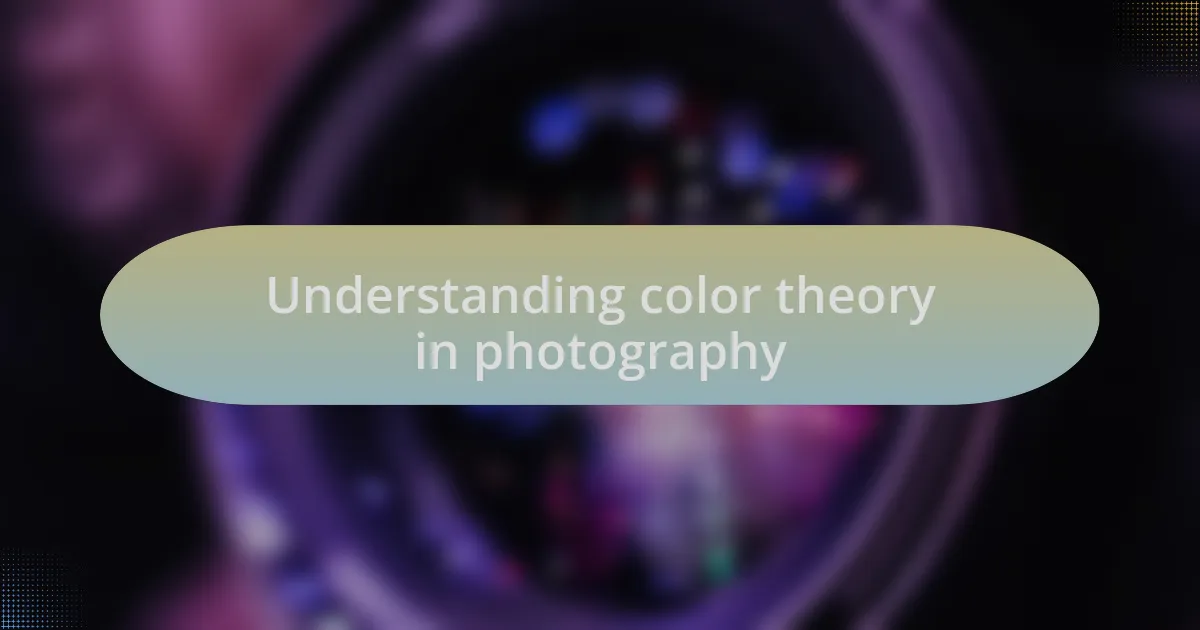
Understanding color theory in photography
Color theory in photography is essential because it profoundly influences how an image is perceived. I remember the first time I experimented with complementary colors—like vibrant red against a lush green background. The way those colors played off each other brought a depth to the photo that I hadn’t achieved before. Doesn’t that just highlight how color can evoke different emotions?
When I look at color palettes, I often think about the emotional responses they can generate in viewers. For instance, warm colors often create feelings of warmth and comfort, while cooler hues might evoke calmness or sadness. Have you ever noticed how a sunset, filled with oranges and purples, makes you feel nostalgic? That’s the beauty of color theory in action, manipulating our feelings and experiences through visual art.
In practice, understanding color theory can elevate your photography. I find that using analogous color schemes can create harmony in my compositions. When I shot a series of portraits nestled in a field of wildflowers, the continuity of colors made the subject pop, immersing the viewer in a serene environment. How do you think your photos could change if you paid closer attention to the colors you’re using?
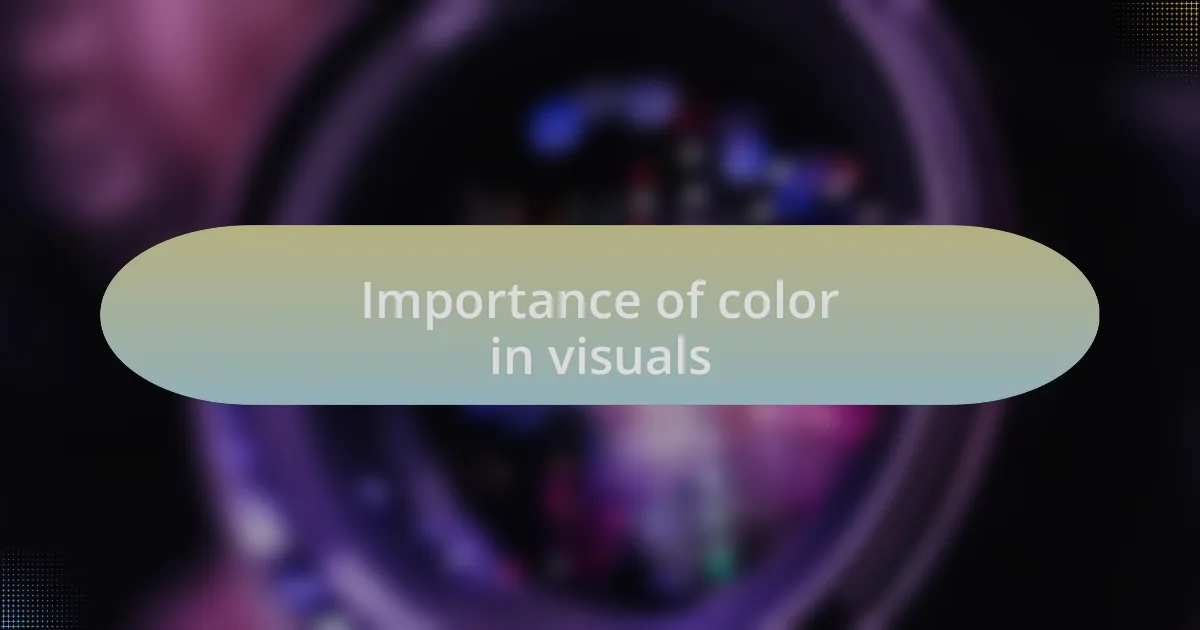
Importance of color in visuals
Color serves as the visual language in photography, speaking volumes without uttering a word. I recall a photoshoot where I deliberately used a monochromatic scheme, showcasing different shades of blue. This choice not only created a cohesive look but also immersed viewers in a tranquil atmosphere that felt almost meditative. Have you ever noticed how a singular color can transport you into a specific mood?
When I think of the importance of color, I remember a vibrant market scene I captured, bursting with hues that represented the local culture. Each color told a story, grabbing attention and inviting viewers to explore every detail. It’s astonishing how the strategic use of bright yellows and reds can evoke a sense of energy and excitement, isn’t it?
Moreover, color can guide a viewer’s focus within an image, highlighting essential elements. I often utilize contrasting colors to draw attention to a subject against a busy background. The first time I did this with a bright orange flower in a sea of green proved that color could lead the eye where I wanted it to go, transforming a simple photo into a striking focal point. How could you use color to enhance the messages in your own images?
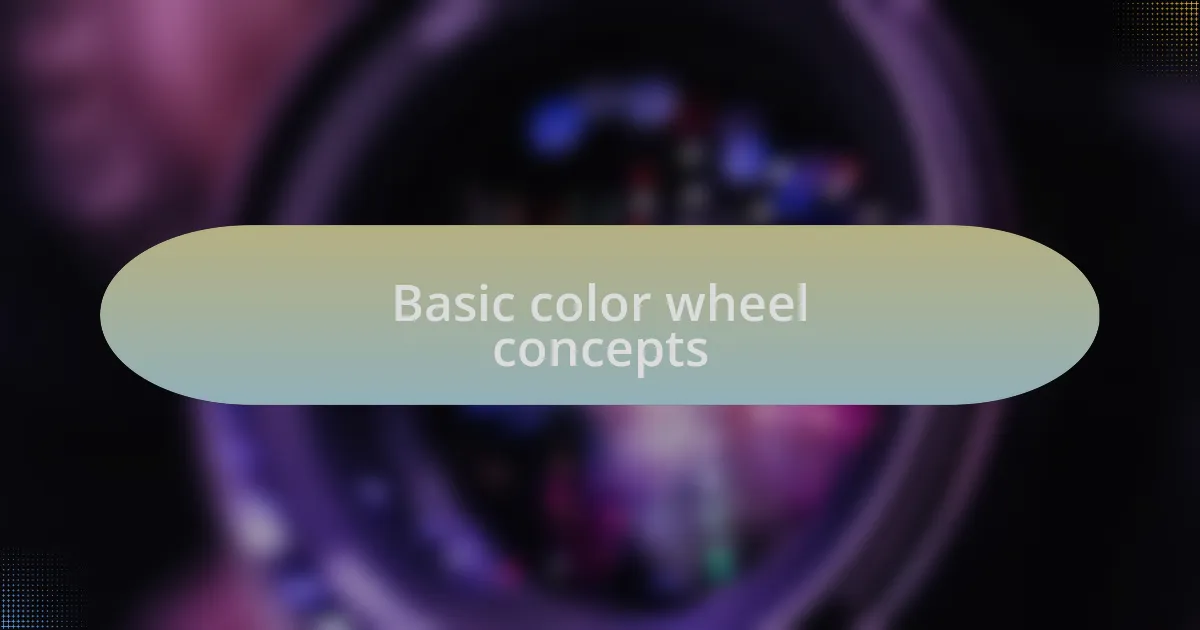
Basic color wheel concepts
Understanding the color wheel is foundational for any photographer. I remember when I first encountered it; I was fascinated by how primary colors—red, blue, and yellow—combine to create a spectrum of shades. It struck me that just making slight adjustments could entirely change the mood of an image. Have you ever tried mixing colors on a palette and noticed how some hues resonate more with you than others?
Exploring complementary colors, which are opposite each other on the wheel, was a game-changer for me. I once captured a scene with a bright yellow sunflower set against a deep purple backdrop, and the contrast instantly made the flower pop. The vibrant pairing not only created visual interest but evoked an emotional response in viewers. How often do you take advantage of colors that complement each other in your own compositions?
As I delved deeper into color theory, I learned about the impact of analogous colors, which sit side by side on the wheel. During an autumn photoshoot, I focused on warm yellows, oranges, and reds to convey the season’s warmth and richness. The harmonious blending of these colors created a sense of coziness I wanted to portray. Have you considered how using similar colors can enhance the storytelling in your photography?
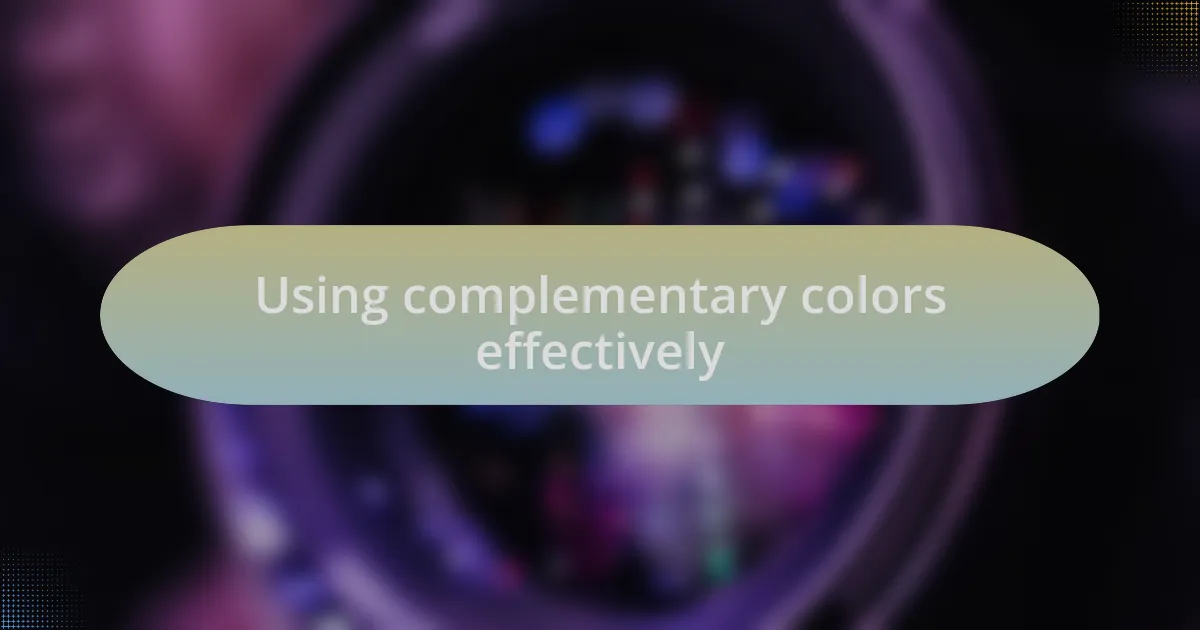
Using complementary colors effectively
When I think of using complementary colors effectively, I can’t help but remember a striking photo I took at sunset. The vivid orange of the sky against the deep blue of the ocean created a captivating scene. The interplay drew viewers in, almost making them feel the warmth of the sun and the coolness of the water simultaneously. Have you ever experimented with this dynamic contrast in your work?
In another instance, I shot a portrait featuring a model wearing a vibrant green dress, set against a backdrop of rich red foliage. The resulting image was so powerful that it created an electric energy, highlighting both the subject and the environment. This taught me that choosing complementary colors isn’t just about aesthetics; it’s about creating a dialogue between elements in a photo. Could your next project benefit from such striking contrasts?
I find that sometimes, the simplest applications yield the most profound results. For instance, using a pop of bright red flowers in an otherwise muted landscape can transform an ordinary scene into something truly engaging. This approach can turn a passerby into a viewer, compelling them to stop and absorb the moment longer. Have you thought about how a small touch of unexpected color could elevate your photography?
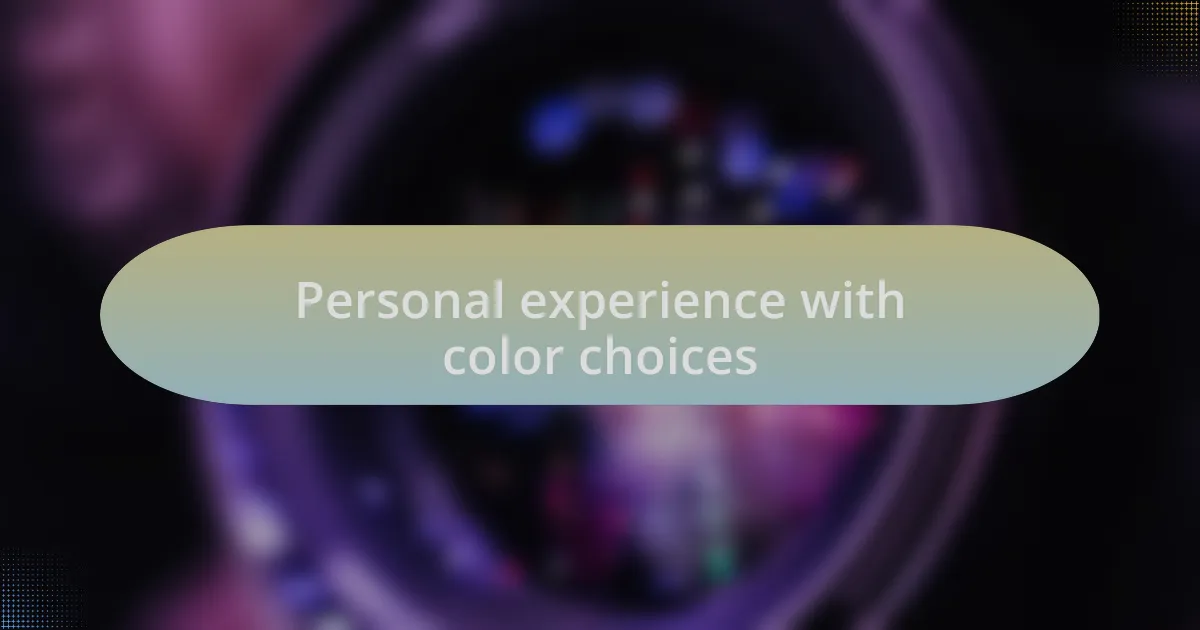
Personal experience with color choices
When I reflect on my own experiences with color choices, I recall a chilly morning at a local park where the fog created a soft, diffused light. I decided to shoot a series of images featuring a single bright yellow sunflower piercing through the haze. That simple choice of color against the subdued backdrop drew not only my eye but also the attention of others around me, prompting them to pause and appreciate the beauty of that moment. Have you ever captured a scene that seemed to glow?
In another scenario, I experimented with color during a wedding shoot. The bride wore a stunning royal blue gown, and I incorporated the golden hues of the autumn leaves surrounding them. The contrast felt extraordinary, enhancing the joy of the occasion and resonating with the couple’s vibrant personalities. I realized then that my color selections could not only convey emotion but also tell a more personal story. Have you considered how the colors in your photographs might reflect the essence of the moment?
Sometimes, I find that subtle color variations play a pivotal role. For example, during a street photography session, I was drawn to a scene where a child in a vivid red jacket played among a sea of gray pavement and buildings. That small splash of color brought the whole image to life, revealing an innocence often overlooked in the hustle of urban life. It made me question: How often are we missing the colors that add depth to our experiences?
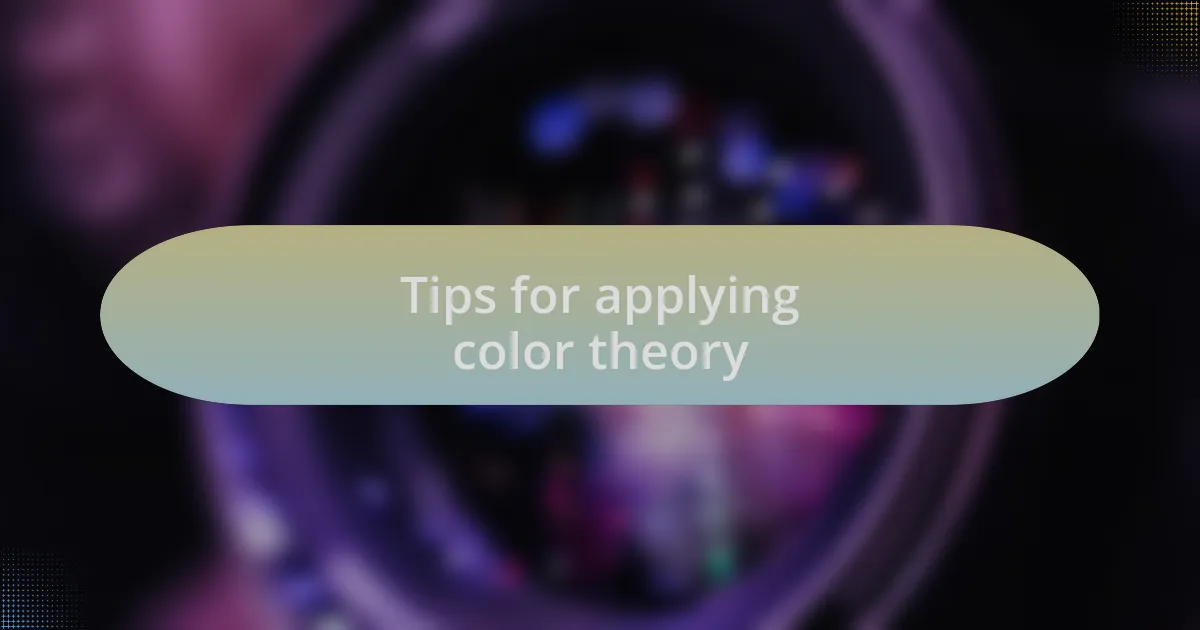
Tips for applying color theory
When applying color theory, I’ve found that establishing a color palette early on makes a significant difference in my work. For instance, during a beach shoot at sunset, I consciously chose to emphasize the warm oranges and pinks of the sky, allowing them to complement the soft blues of the water. This not only enhanced the overall harmony of the images but also evoked a serene, dreamy quality that truly captured the essence of the moment. Have you ever thought about how a well-structured palette can elevate your photography?
Another tip I’ve embraced is paying attention to complementary colors. A memorable moment for me was photographing a local festival. I noticed lively purple flowers against the bright green foliage, which created an electric visual impact. By positioning my subject against this contrasting backdrop, I highlighted their energy while enriching the overall composition. It made me realize: how can the use of contrasting colors add excitement to your shots?
Experimenting with color temperature has also been a game changer. I remember a chilly evening shoot where I used warmer filters to infuse a cozy atmosphere into my night cityscape photos. This simple adjustment shifted the mood dramatically, inviting viewers to feel the warmth among the cool evening air. I often wonder, how might tweaking color temperatures influence the emotional connection viewers have with your work?